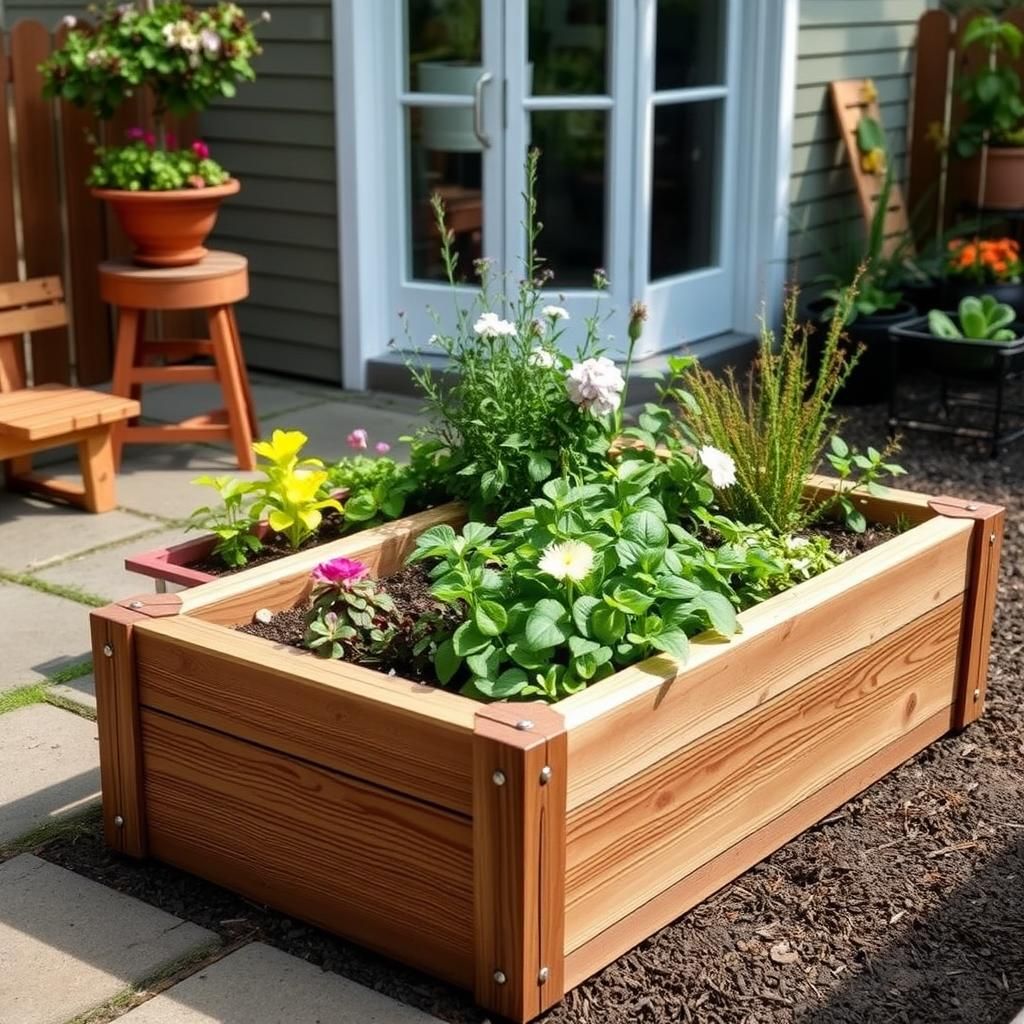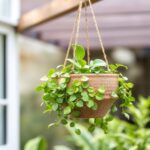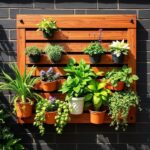10 Creative Ideas to Enhance Your Outdoor Space with Raised Garden Bed Planter Boxes

Transforming your outdoor space can be a rewarding endeavor, and one of the most effective ways to do this is through raised garden bed planter boxes. These versatile structures not only add aesthetic appeal to any yard or patio but also offer practical benefits such as improved soil quality and easier accessibility for gardening. In this article, we will explore ten creative ideas to enhance your outdoor area using raised garden beds. From vertical gardening to incorporating unique materials, these innovative approaches will inspire you to cultivate a vibrant and productive garden that complements your lifestyle and outdoor environment.
Benefits of Raised Garden Bed Planter Boxes
Raised garden bed planter boxes offer numerous advantages for gardening enthusiasts and novices alike. By elevating the soil, these planters provide excellent drainage and allow for a more controlled growing environment, minimizing the risk of soil compaction and improving root health. Additionally, they can be constructed at a comfortable height, reducing strain on the back and knees during planting and maintenance. The use of raised planter boxes also helps in preventing soil erosion and keeps pests at bay, making it easier to manage weeds and protect plants. Furthermore, they can be designed in various sizes and materials, allowing gardeners to customize their space to fit specific needs and aesthetics, fostering a more enjoyable and productive gardening experience.
Materials Used for Raised Garden Beds
When constructing raised garden bed planter boxes, various materials can be utilized, each offering distinct benefits. Common options include wood, such as cedar or redwood, which is naturally resistant to rot and provides an aesthetically pleasing look. Composite materials are also popular as they combine recycled materials with wood fibers, resulting in a durable, weather-resistant product. For a more modern approach, metal beds, typically made of galvanized steel, are gaining popularity due to their longevity and sleek design. Additionally, bricks or stones can be used to create a more permanent structure that adds a unique character to the garden. Each material selection impacts not only the visual aspect but also the growing conditions within the planter boxes.
Design Considerations for Raised Garden Beds
When designing raised garden bed planter boxes, several factors should be taken into account to optimize both functionality and aesthetics. The size of the beds is crucial; a width of 4 feet is often recommended to ensure easy access for planting and maintenance without stepping onto the soil. The height should be adjusted according to the gardener's physical needs, typically ranging from 12 to 36 inches, promoting comfort while gardening. Proper spacing between beds is essential for ease of movement and access, often ranging from 2 to 3 feet. Additionally, incorporating pathways or borders can enhance the design and provide a well-defined structure to the garden area, making it more visually appealing.
Soil Composition for Raised Planter Boxes
The soil composition for raised garden bed planter boxes is vital for promoting healthy plant growth. A high-quality soil mix typically consists of topsoil, compost, and additional amendments to enhance nutrient content and drainage. A general recommendation is to blend two parts topsoil with one part compost and one part peat moss or coconut coir, creating a light, well-draining mixture that retains moisture without becoming waterlogged. Adding organic fertilizers or worm castings can further enrich the soil, providing essential nutrients over time. Regular soil testing is advised to ensure pH and nutrient levels remain optimal for the plants being grown.
Pest Management in Raised Garden Beds
Raised garden bed planter boxes can significantly aid in pest management, as they create an environment that can be easier to monitor and control. The elevation of the beds makes it more difficult for many ground-dwelling pests to access the plants. Implementing row covers or netting can provide an additional layer of protection against insects and birds. Introducing beneficial insects, such as ladybugs and lacewings, can help keep pest populations in check naturally. Additionally, integrating companion planting techniques and utilizing organic pesticides when necessary can create a balanced ecosystem within the raised beds, promoting healthy plant growth while minimizing chemical reliance.
| Feature | Benefit |
|---|---|
| Drainage | Improves root health and prevents waterlogging |
| Height | Reduces strain on the back and knees |
| Soil Composition | Ensures optimal nutrient availability and moisture retention |
| Pest Management | Facilitates easier control and monitoring of pest populations |
| Visual Appeal | Allows customization and enhances the aesthetic of the garden space |
What is the difference between a raised garden bed and a planter box?

The main difference between a raised garden bed and a planter box lies in their structure, size, and intended use. Both are useful for gardening, but they serve different purposes and can be constructed from various materials to suit different needs.
A raised garden bed is typically a large, rectangular plot of soil that is elevated above the surrounding ground. It is often enclosed by wooden or stone borders to hold the soil in place and can range from a few inches to several feet in height. Raised garden beds promote good drainage, soil warmth, and reduced weed growth, making them ideal for growing vegetables, herbs, and flowers. They are usually larger in scale, allowing for more extensive gardening activities.
On the other hand, a planter box is generally smaller and more versatile. It is usually a box-shaped container designed to hold soil and plants, often placed on patios, balconies, or decks. Planter boxes can come in various shapes and sizes, and are often used for ornamental plants or smaller gardening projects. Their compact nature makes them suitable for urban settings where space is limited.
Structure and Size
Raised garden beds are often built on the ground and can be quite large, allowing for significant soil volume and depth for plant roots. In contrast, planter boxes are self-contained containers that can be made from a variety of materials, like wood, plastic, or metal, and usually cater to smaller planting areas.
See also:
- Raised Garden Beds: Typically larger and more expansive.
- Planter Boxes: Generally smaller, perfect for limited spaces.
- Material Variety: Both can use different materials but planter boxes are often more decorative.
Purpose and Use
The primary purpose of raised garden beds is to create a dedicated space for growing vegetables and flowers with better soil quality and drainage. Planter boxes, however, can be used for a variety of purposes, including decorative displays of flowers or herbs and even for creating vertical gardens in small spaces.
- Raised Garden Beds: Primarily for food production and serious gardening.
- Planter Boxes: Used for aesthetics and versatile plant varieties.
- Growing Environment: Raised beds offer a better growing environment due to improved soil conditions.
Drainage and Soil Quality
Raised garden beds inherently feature excellent drainage due to their elevation above ground level. This helps prevent waterlogging and promotes healthy root systems. Planter boxes can also offer good drainage, but their smaller size may require more management of moisture levels to prevent overwatering.
- Drainage Capabilities: Raised beds provide natural drainage with less effort.
- Soil Quality Maintenance: Easier to amend the soil in raised beds than in smaller planter boxes.
- Water Retention: Planter boxes may need extra attention to retain moisture based on size.
Planting Versatility
Raised garden beds allow you to plant a wider variety of crops, particularly larger vegetables, due to their depth and soil volume. Planter boxes are more constrained in terms of the types of plants they can support, typically favoring smaller herbs and flowers.
- Variety of Crops: Raised beds can host large veg plants, while planter boxes are ideal for herbs and flowers.
- Seasonality: Raised beds often provide longer growing seasons.
- Crop Rotation: Easier to manage crop rotation in larger areas like raised beds.
Installation and Maintenance
Creating a raised garden bed may involve more initial labor, including building the frame and filling it with soil. Planter boxes tend to be easier to install, requiring less preparation and less space. Maintenance may also differ, as raised gardens may need more weeding due to their size, while planter boxes may require frequent monitoring for pests and diseases.
- Installation Effort: Raised beds need more time and effort to construct.
- Maintenance Needs: Planter boxes are often easier to maintain.
- Cost Consideration: Costs can vary based on the size and materials used for both options.
How deep should a raised bed box be?

A raised bed box should typically be at least 12 inches deep to provide ample room for root development and to support healthy plant growth. However, the depth can vary depending on the types of plants you intend to grow. For shallow-rooted plants, a depth of 6 to 8 inches may suffice, while deeper-rooted vegetables and perennials may require 18 to 24 inches. The depth of the raised bed can influence drainage, soil health, and the overall success of your garden.
Choosing the Right Depth Based on Plant Type
When deciding on the depth of your raised bed, consider the specific requirements of the plants you plan to grow. Different plants have varying root depths and space needs.
- Shallow-Rooted Plants: Examples include lettuce, radishes, and herbs, which can thrive in beds as shallow as 6 to 8 inches.
- Medium-Rooted Plants: Carrots, beets, and onions typically require about 12 inches of depth for adequate root growth.
- Deep-Rooted Plants: Tomatoes, squash, and perennials generally thrive in beds that are 18 to 24 inches deep.
Benefits of Deeper Raised Beds
A deeper raised bed can provide several advantages that promote better growth conditions for plants.
- Better Drainage: Deeper beds allow for improved drainage, preventing waterlogging and promoting healthier root systems.
- Soil Health: A greater depth allows for layering different soil types, enhancing soil fertility and nutrient availability.
- Extended Growing Season: Deeper beds retain heat longer, which can promote an extended growing season for warm-weather crops.
Considerations for Comfort and Accessibility
The height of the raised bed also plays a part in comfort and accessibility, especially for gardeners with physical limitations.
- Ease of Maintenance: A depth of about 12 to 18 inches often offers a comfortable working height, reducing strain on the back.
- Accessibility: Consider building taller beds (up to 36 inches) for wheelchair accessibility and easier maintenance.
- Design: The design of the raised bed should factor in the gardener's needs—ensuring ease of reach without overextending.
Soil Composition and Layering
The soil composition within a raised bed can affect how deep it should be, as different materials have different retention and drainage properties.
- Layering Materials: Incorporate materials like compost, topsoil, and mulch to create a rich, nutrient-dense environment.
- Soil Settling: Over time, soil may settle, so starting with an extra few inches can compensate for this shift.
- Root Space: Always consider the final depth of the soil after factoring in the settling and layering of the materials.
Cost Considerations for Building Deeper Beds
The depth of your raised bed can impact the overall cost of materials and construction.
See also:
- Material Costs: Deeper beds require more soil and materials, which may increase the overall budget for gardening.
- Soil Volume: Calculate the volume of soil needed based on the dimensions and depth to estimate costs effectively.
- Long-Term Investment: Investing in deeper beds can yield better harvests and improve soil health, providing good value over time.
What do you put in the bottom of a raised garden box?

To create an effective environment for your plants, it is essential to consider what you put at the bottom of a raised garden box. The materials you choose can significantly influence plant health, drainage, and soil quality.
Drainage Layer
A good drainage layer is crucial for preventing waterlogging in your raised garden box. This layer helps to facilitate excess water movement away from the roots, which can lead to root rot. Here are some common materials to consider for your drainage layer:
- Gravel: Provides excellent drainage and allows water to flow freely.
- Rock Mulch: Can also serve as a decorative layer while helping with drainage.
- Ceramic Pots: Broken pieces can create space for water to move while reducing soil erosion.
Weed Barrier
To minimize competition for nutrients, it's essential to install a weed barrier at the bottom of your raised garden box. This can help prevent weeds from invading your garden. Common options include:
- Landscape Fabric: Allows water and nutrients to seep through while blocking weeds.
- Cardboard: A biodegradable option that decomposes over time, enriching the soil.
- Newspaper: Effective at blocking weeds and also breaks down to enhance soil health.
Organic Matter
Adding organic matter can enrich your soil and improve its structure. This layer contributes nutrients that are essential for plant growth. Consider the following materials:
- Compost: A nutrient-dense option that enhances soil fertility and texture.
- Leaf Mold: Decomposed leaves that improve moisture retention.
- Straw: Helps improve soil aeration and breaks down to enrich the soil.
Soil Composition
The soil you place in your raised garden box is critical for plant development. A high-quality soil mix should include a balance of various components. Key ingredients to consider are:
- Topsoil: Forms the base of the soil mix, providing essential minerals.
- Potted Mix: Contains fertilizer and aids in moisture retention.
- Perlite or Vermiculite: Improves aeration and drainage for healthy root growth.
Protection from Pests
To ensure your plants thrive, protecting them from pests is vital. This can be achieved by incorporating specific materials into your garden box. Options include:
- Hardware Cloth: A wire mesh that keeps larger animals out.
- Organic Insect Dausters: Can be sprinkled at the bottom to deter insects.
- Cinnamon or Diatomaceous Earth: Natural deterrents that also benefit soil health.
Questions from Our Readers
What are raised garden bed planter boxes?
Raised garden bed planter boxes are elevated structures designed to facilitate gardening by providing a controlled environment for plants. They are typically filled with nutrient-rich soil, allowing for better drainage and easier access for gardeners, reducing the need to bend down.
What materials are used to make raised garden bed planter boxes?
Raised garden bed planter boxes can be made from various materials including wood, metal, and plastic. Each material has its own benefits, such as wood being aesthetically pleasing while metal offers durability, thus choosing the right material can depend on the gardener's preferences and budget.
How do I choose the right size for my raised garden bed planter box?
The right size for a raised garden bed planter box depends on your available space and the types of plants you wish to grow. A common size is 4 feet by 4 feet, which allows easy access from all sides, while height can vary based on the depth of root systems of the plants you are selecting.
Are raised garden bed planter boxes suitable for all types of plants?
Yes, raised garden bed planter boxes can accommodate a wide variety of plants, from vegetables and herbs to flowers. It's crucial to consider the growth requirements of each plant, such as sunlight, soil type, and water needs, to ensure a successful garden.
See also:

If you want to read more articles like 10 Creative Ideas to Enhance Your Outdoor Space with Raised Garden Bed Planter Boxes, we recommend you check out our Planter category.
Leave a Reply
Related Articles